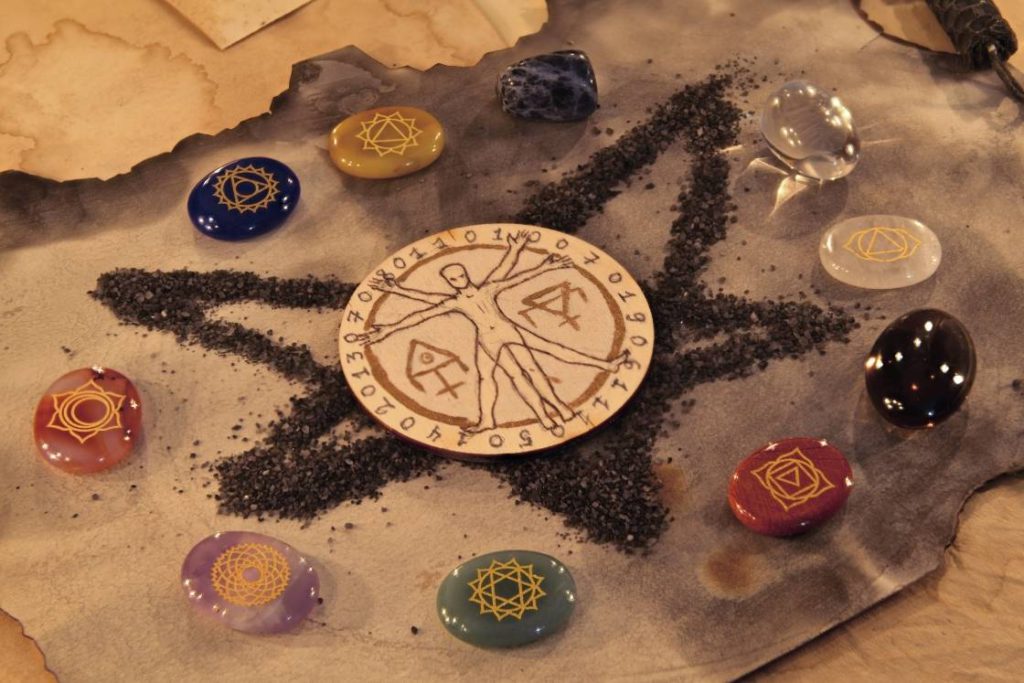
Chakra symbols are visual representations of the seven main energy centres in the human body. Each chakra symbol holds deep meaning and reflects the unique qualities of its chakra through shapes like circles, triangles, squares, and lotus petals. These symbols often include a Sanskrit syllable (bija mantra), a guiding deity, and a symbolic animal each adding layers of spiritual significance.
In yogic and tantric traditions, these elements are more than just artistic designs they represent the inner energies that shape our physical, emotional, and spiritual well-being. By understanding the meaning behind each symbol, practitioners can connect more deeply with the chakras and support the free flow of energy through meditation, mantra, and focused awareness..
Key elements of chakra symbols
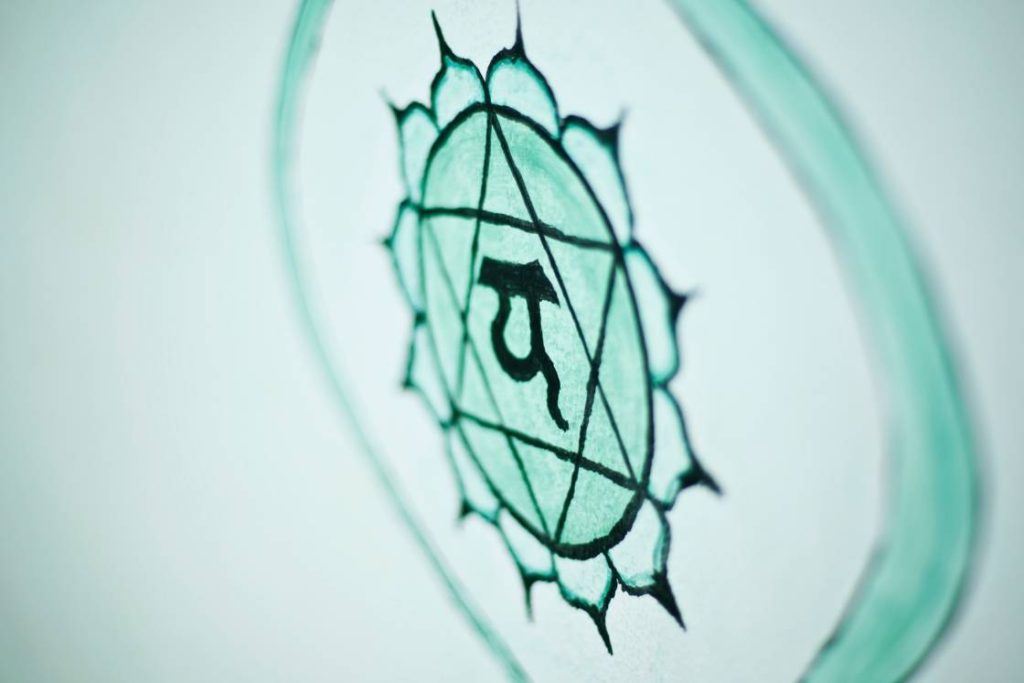
Before we explore the seven chakra symbols in detail, let’s first understand the key elements commonly found in each symbol:
1. Square – The square represents a strong foundation, the physical body, conscious awareness, and the need for stability. It often appears in the symbols of the lower chakras, which are more focused on grounding and our connection to the Earth.
2. Triangle – The triangle symbolises the direction of energy flow. Its three points represent the union of mind, body, and soul. A downward-pointing triangle shows grounding energy, while an upward-pointing triangle reflects the rise of consciousness.
3. Hexagram – Formed by two intersecting triangles, the hexagram represents the union of masculine and feminine energies, or the harmony between earthly and divine qualities.
4. Circle – The circle, commonly found in all chakra symbols, represents the continuous flow of life-force energy (Prana), transformation, and wholeness. It symbolises movement and the dynamic nature of energy within the chakras..
5. Lotus flower – The lotus symbolises spiritual growth and enlightenment. The number of petals on each lotus represents the nadis (energy channels) converging at that chakra. More petals indicate a greater flow of energy.
Also Read: What Are Nadis? The Three Main Nadis: Ida, Pingala, Sushumna
6. God – Each chakra is linked with a specific Hindu deity or divine pair (God and Goddess) whose qualities influence the chakra’s function and energy.
7. Animal – Certain animals are associated with chakras to symbolise their power and nature. Meditating on these animals can support balance, inner strength, and alignment.
8. Sanskrit syllable – At the centre of each chakra’s mandala is a Sanskrit syllable, known as the Bija (Seed) Mantra. Chanting these mantras activates and harmonises the chakra’s energy.
9. Color – Each chakra has its own colour, corresponding to a frequency within the visible light spectrum. These colours help indicate the energetic qualities of each chakra and are often used in healing and meditation practices..
1. Root chakra symbol meaning
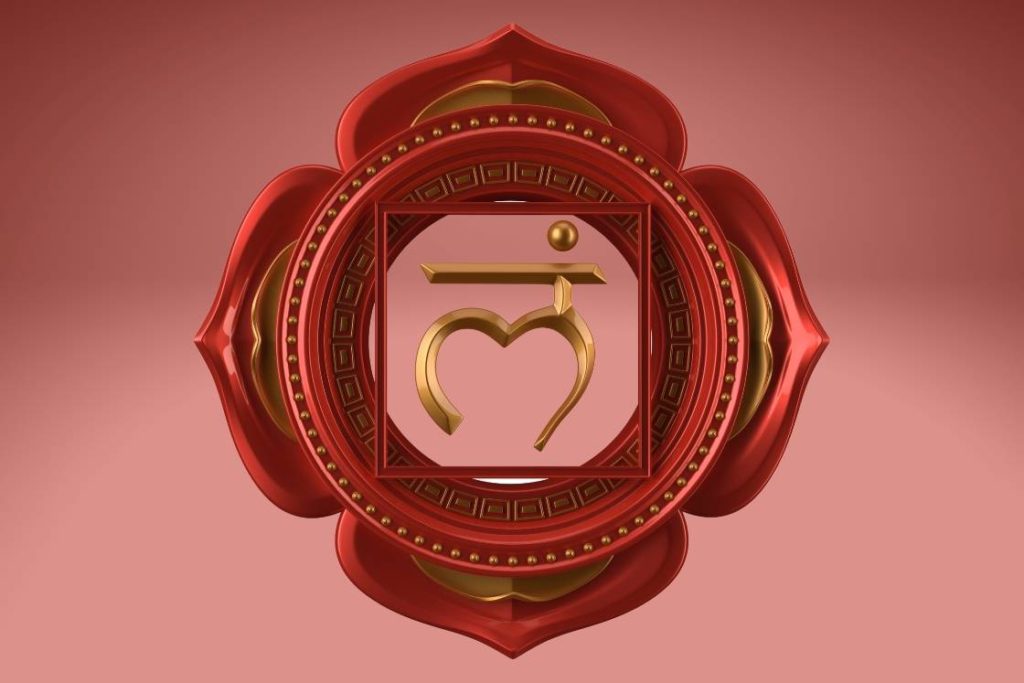
| Chakra | Root chakra (Muladhara) |
| Symbol Geometry (Mandala) | A red inverted triangle within a bright yellow square. And the triangle and the square further within a circle. |
| Lotus | 4 Lotus petals are on the circumference of the circle. |
| God / Goddess | Ganesha and Goddess Dakini |
| Animal | Elephant |
| Seed Mantra | LAM |
| Color | Red |
The Root Chakra is symbolized by a red-colored four-petaled lotus mandala that is centered by a red inverted triangle within a bright yellow square. It is the foundational chakra and its main functions are to keep one’s body grounded, survival, stability, safety, comfort, and self-identity in the physical world.
The triangle and square symbol
The small inverted triangle at the centre of the Root Chakra symbol represents the downward flow of energy toward the Earth. It symbolises expansion, grounding, and the awakening of Kundalini energy reminding us to stay rooted and connected to our physical existence.
The square surrounding the triangle reflects the chakra’s stabilising nature. With its four equal sides, the square signifies structure, balance, and foundation. It is often linked with the four seasons spring, summer, autumn, and winter—and the four cardinal directions: north, south, east, and west, highlighting the chakra’s connection to nature and the material world.
Petals
Four lotus petals of the Root Chakra symbolises the Four important Nadis, which show the four functions of mind; manas, Chitta, ahamkara, and buddhi. These petals are also decorated with 4 golden-colored Sanskrit syllables (Vam, Śaṃ, Ṣaṃ, and Saṃ) which correspond to the 4 stages of human consciousness; Joy, Natural Pleasure, Delight in controlling passion and Blissfulness in concentration.
Seed symbol
Sanskrit syllable “LAM” written at the center of the root chakra symbol is its seed mantra. Sound vibration created by chanting “LAM” promotes grounding, stimulating the energy of the Muladhara chakra, and is associated with stability & a sense of being rooted to the earth. The other four Sanskrit syllables which are written on lotus petals also get resonated whenever the seed mantra “LAM” is pronounced loudly.
2. Sacral chakra symbol meaning
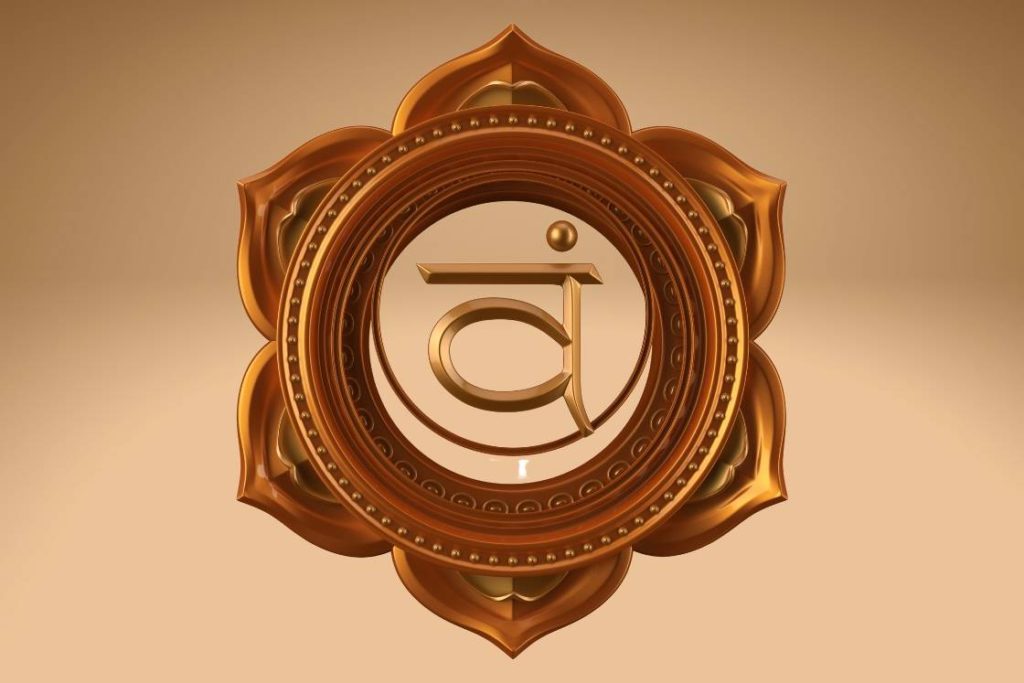
| Chakra | Sacral Chakra (Swadhisthana) |
| Symbol Geometry (Mandala) | Circle with the crescent moon symbol in the middle. |
| Lotus | 6 Lotus petals are on the circumference of the circle. |
| God / Goddess | Brahma and Goddess Rakini |
| Animal | Makara (Crocodile) |
| Seed Mantra | VAM |
| Color | Orange |
The Sacral Chakra symbol is an orange lotus mandala with six petals and two large concentric circles at its centre. These circles form a crescent moon shape, symbolising the water element. This connection to water reflects the chakra’s role in emotional flow, creativity, sensuality, and the ability to experience pleasure and joy in life.
Circle and crescent moon
The concentric circles in the Svadhisthana Chakra symbolize the cyclic nature of birth, death, and rebirth. They also refer to interminable transitions that change periodically and encourage every being to flow freely. The crescent moon depicts femininity in this chakra as it reflects the time that is continuously flowing without interruption or any change. Distinctive shade or phases of the moon are symbolised with infinity, immortality, and the illumination of the dark side of nature.
Petals
The Six petals of the Sacral Chakra are decorated with 6 vermillion-colored Sanskrit syllables: बं baṃ, भं bhaṃ, मं maṃ, यं yaṃ, रं raṃ, and लं laṃ. These syllables show six negative aspects of one’s nature: wrath, hate, jealousy, cruelty, lust, and pride. Opening of the sacral chakra is related to overcome these negative aspects by self-control on own nature.
Symbolic animal and god
The crocodile (or Alligator) is the symbolic animal of the sacral chakra which is depicted behind the shape of the crescent moon. Just like a crocodile, a person with a dominant sacral chakra shows fierceness, authority, creativity, and relationship with the water element.
Brahma is the symbolic god of sacral chakra whose energy makes it the center of new creation and creativity. Along with Brahma, the goddess Rakini resides in this chakra sitting on a crocodile. She is considered the goddess of self-expression.
3. Solar plexus chakra symbol meaning
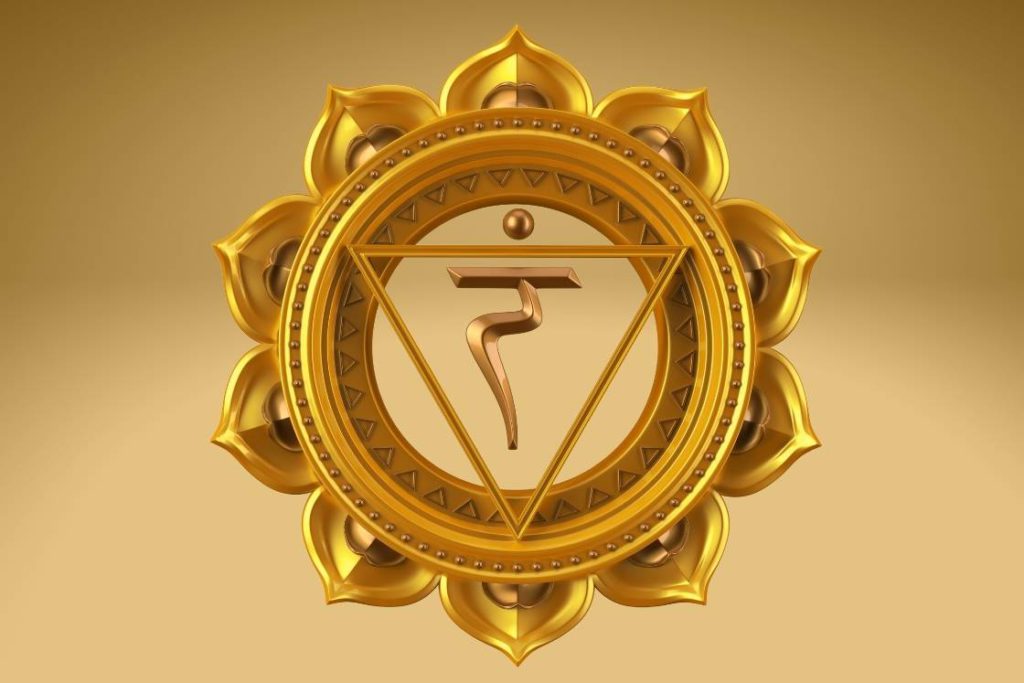
| Chakra | Solar plexus chakra (Manipura) |
| Symbol Geometry (Mandala) | The red inverted triangle is within a bright yellow circle. A dot is also shown at the center of the inverted triangle; it’s the place of the seed mantra. |
| Lotus | 10 yellow-colored lotus petals on the periphery of the above circle |
| God / Goddess | Vishnu and Lakini Shakti |
| Animal | Ram (male sheep) |
| Seed Mantra | Sanskrit syllable ‘RAM’, written on the dot inside the triangle. |
| Color | Yellow |
The Solar Plexus Chakra governs personality, self-esteem, and ego. These qualities arise from its connection to the element of fire, symbolised by the yellow and dark red colours in its chakra symbol.
The circle and triangle
The symbol of the solar plexus chakra is made up of a yellow color circle containing a red inverted triangle. On each side of the triangle, 3 T-shaped arms combinedly depict a variation of Swastika; the symbol of auspiciousness. Its yellow circle has a common meaning as of other chakras symbols i.e. life, rebirth, and spiritual awakening.
The red triangle in the center of the solar plexus chakra symbolizes the triangle of fire or “Tejas” (in Sanskrit) that can be associated with the essence of power and strength. Tejas means sharpness and therefore, Manipura with its sharpness of fire holds the ability to burn, transform and purify the energy in the form of thought, emotion, and food.
Petals
Ten petals of Manipura have a Sanskrit syllable pha, pa, na, dha, da, tha, ta, nna, ddha, and dda. These represent the ten blocking qualities that hinder the spiritual awakening of a person and must be overcome to fully open this Chakra. These respectively are; sadness, foolishness, delusion, disgust, fear, shame, treachery, jealousy, ambition, and ignorance.
There is another meaning too associated with these petals. Solar plexus chakra is considered the place of meeting 10 Pranas (5 Prana Vayus and 5 Upa Prana Vayus). Ten petals show convergence of all pranas, therefore, the solar plexus governs the whole body’s metabolism, vitality, and immunity.
Symbolic god
Since the Solar Plexus Chakra nourishes the body, it is believed to be associated with preserver or sustainer god Vishnu and Goddess Lakshmi. He represents the evolving human consciousness that leads the person to self-realization. Goddess Lakshmi represents material and spiritual prosperity.
4. Heart chakra symbol meaning
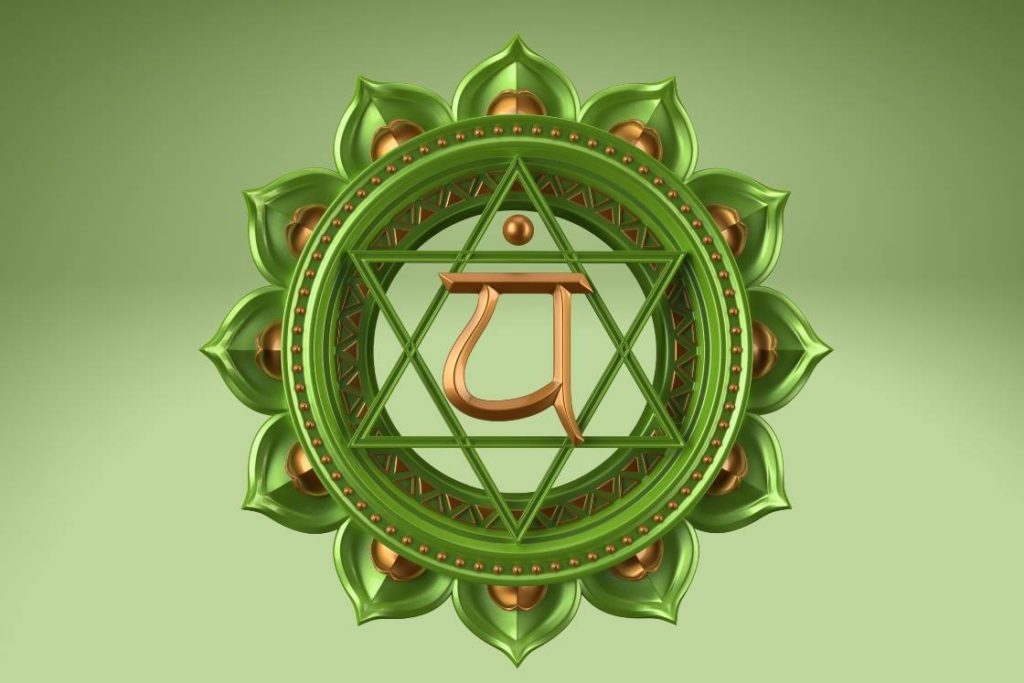
| Chakra | Heart Chakra (Anahata) |
| Symbol Geometry (Mandala) | Inside the lotus circle, two triangles creating a hexagram. |
| Lotus petals | 12 mental vrittis and divine qualities of the heart |
| God / Goddess | Rudra and Kakini shakti |
| Animal | Deer or antelope |
| Seed Mantra | YAM |
| Color | Green |
The Anahata, or Heart Chakra, is symbolised by a lotus with 12 petals in deep red or vermilion. At its centre, two interlocking triangles one pointing upward and the other downward—form a six-pointed star known as the Shatkona or hexagram. This sacred geometric figure is a type of Yantra used in Hindu rituals, symbolising the union of masculine (Shiva) and feminine (Shakti) energies.
Triangles
The intersecting triangles of Anahata symbolize the heart chakra is the meeting place of Purusha (consciousness) and Prakriti (matter) or the feminine and masculine aspects. Indeed, the lower 3 chakras (Muladhara, Swadhisthana, Manipura) and upper 3 chakras (Vishudha, Ajna, Sahasrara) are respectively the “chakras of matter” and “chakras of consciousness”. Triangles of Anahata chakra represent the connection of the “Matter” and “Consciousness”.
Petals
12 petals of heart chakra have a Sanskrit syllable: syllables kam, kham, gam, gham, ngam, cham, chham, jam, jham, nyam, tam and tham. The sound of these syllables corresponds to twelve mental states or “vrittis”: fraud, lustfulness, indecision, hope, anxiety, repentance, possessiveness, incompetence, discrimination, impartiality, arrogance, and defiance. Overcoming these vrittis opens up the divine qualities associated with the heart chakra.
Seed symbol
At the center of the heart chakra symbol, there is the seed syllable “YAM” which on chanting can regulate the air element in the body. Hindu deity “Vayu” governs this area and his presence is shown by the dark-gray smoky region representing air/clouds. However, Shiva’s Rudra form is the main god of the heart chakra and goddess Kakini is his manifest shakti (power).
Symbolic animal
The deer or antelope is a symbolic animal of the heart chakra. Antelope represents shyness and vulnerability, but also attentiveness, innocence, gentleness, and grace.
5. Throat chakra symbol meaning
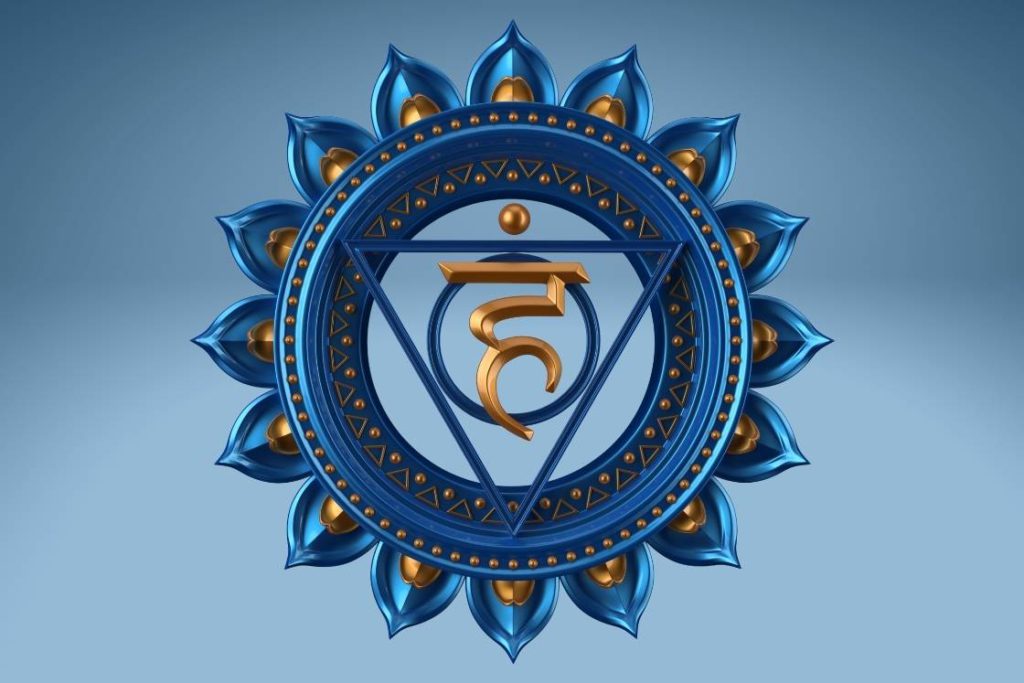
| Chakra | Throat chakra (Vishuddha) |
| Symbol Geometry (Mandala) | A triangle inside a large lotus circle. Inside the triangle, there is a small circle and on it, the seed mantra HAM is written. |
| Lotus petals | 16 |
| God / Goddess | Sadashiva and Shakini Shakti |
| Animal | White elephant |
| Seed Mantra | HAM हं |
| Color | Blue |
The Throat Chakra symbol features a blue lotus with sixteen purple-coloured petals. At its centre is a sky-blue downward-pointing triangle enclosing a white circle, resembling a full moon. The circle is positioned so that it touches the midpoint of each side of the triangle, symbolising expansion and openness. This design represents the element of Akash (ether) the subtle space through which sound and communication flow.
Triangle
The inverted triangle is an important symbol in the Throat Chakra that directly expresses a body’s higher self and acts as a channel to that same body’s soul and consciousness. It is affiliated with the knowledge that leads to enlightenment. In simple terms, such a triangle in the chakra gives a meaning that the energy is flowing upwards in a body.
Inside the inverted triangle, a small circle in the center of the Vishuddha Chakra symbolizes the cosmic sound called ‘Nadam’. Nadam is defined as the great cosmic vibration present in the inner silence during deep meditation.
Seed symbol
“HAM” is the seed syllable of the Throat Chakra. It is written in white color and is centralised within the small circle or sphere of the chakra. The syllable is associated with ether or swirling dark grey akasha (sky) and other metaphysical energy centers along the spine. This is because they are believed to activate the energy of their specific chakras with calmness.
Petals
The sixteen petals in the Vishuddha Chakra are corresponding to the sixteen vowels in the Sanskrit alphabet also called Vrittis. Vishuddha Chakra impacts the communicating ability because the association with the vowels is very much correlated because of their light, airy, easy pronouncing communicative nature.
Symbolic Animal
The symbolic animal of Throat Chakra is White Elephant (Airavata) because both the chakra and the animal carry the sound mantra “HAM” while epitomizing the Hindu thunder God Indra. The white elephant is regarded as the symbol of strength, luck, and prosperity.
6. Third eye chakra symbol meaning
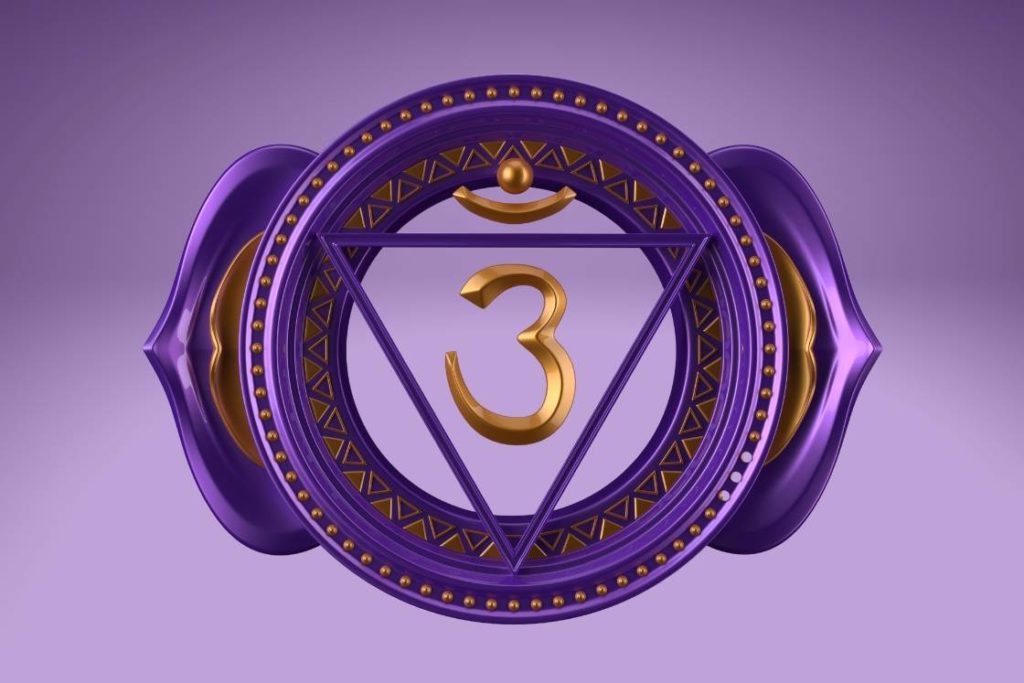
| Chakra | Third eye chakra (Ajna) |
| Symbol Geometry (Mandala) | Purple circle with two petals on its periphery |
| Lotus petals | 2 |
| God / Goddess | Sadashiva and Shakini Shakti |
| Animal | White elephant |
| Seed Mantra | OM |
| Color | Indigo |
The Third Eye Chakra is linked to inner wisdom, clarity, and intuition. Its symbol features a purple lotus with two petals and a downward-pointing triangle at the centre. The two petals represent the meeting of the Ida and Pingala nadis, while the triangle symbolises expanded awareness and spiritual insight. Together, they reflect the awakening of higher perception and the pursuit of enlightenment.
Petals
The two petals of Ajna represent two major nadis (left & right sides nadis) Ida and Pingala meeting with the central Sushumna nadi before rising to the crown chakra, Sahasrara. Sanskrit syllable “ham” (हं) and “ksham” (क्षं) written on these two petals represents the Shiva and Shakti.
Triangle
The inverted triangle symbol in Ajna Chakra represents enlightenment while connecting the body with the divine. The symbol also denotes the summarised knowledge gathered from all the lower six chakras which help in expanding one’s divine consciousness.
Seed symbol
The seed syllable of Ajna is OM, also known as “Pranava Om”. The sound of OM is believed to be the supreme sound of the universe. Chanting OM aloud activates the Ajna chakra and opens us to both conceptual and intellectual understanding needed for spiritual development.
Symbolic animal
The Black Antelope is the symbolic animal of Ajna Chakra suggests honest idiosyncrasies such as positivity, integrity, or trustworthiness. Its presence is more likely to connect visions with intuition and introspection instead of an ordinary or physical vision where the brain sees while eyes are still closed.
7. Crown chakra symbol meaning
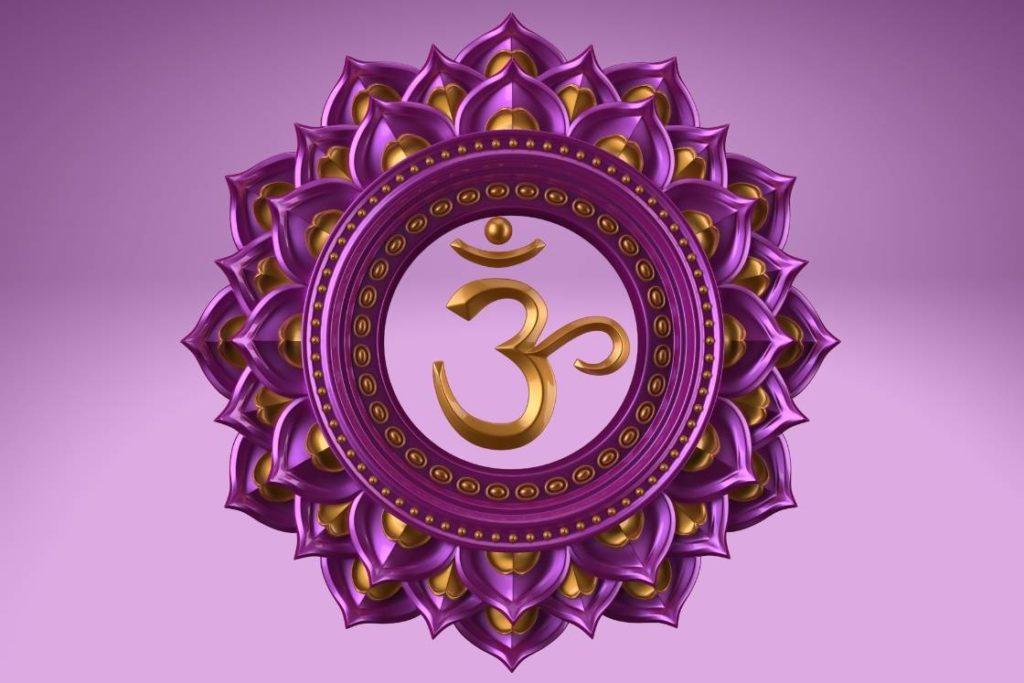
| Chakra | Crown chakra (Sahasrara) |
| Symbol Geometry (Mandala) | A circle in the center, inside of which a seed symbol OM. And around the circle, 1000 petals in layers. |
| Lotus petals | 1000 |
| God / Goddess | Shiva / Kundalini shakti |
| Animal | Cosmic Egg |
| Seed Mantra | OM |
| Color | Violet |
The Crown Chakra symbol represents infinite space and spiritual oneness. It signifies the soul’s connection to the divine and the merging of individual consciousness with the universal source—the origin of all creation.
Petals
The symbol of the crown chakra is depicted with the violet-colored 1,000-petaled lotus flower. It symbolizes the power of kundalini energy in the form of fully blossomed consciousness and violet color adds intuition over consciousness. Lotus petals graphically are arranged in 20 layers in such a way that each layer contains 50 petals.
Circle and seed symbol
The golden color illuminated circular region in the center of the crown chakra symbol seems empty, however, in some illustrations, it includes the seed syllable ‘OM’ or ‘Aum’. This region is a symbolism of open-mindedness and receptiveness. At times, this hollow domain is referred to as a bright full moon that indicates to let go of all types of negativities from the body and accept the art of kindness & forgiveness.
Cosmic Egg is a symbolic animal to Sahasrara that acts as a primitive source to every cosmos and divine exuberance. It is implemented to nurture and transform an atom into a dynamic living substance.
Shiva in his ultimate form resides in the crown chakra and Maha Shakti becomes Kundalini Shakti as she unites with Shiva.


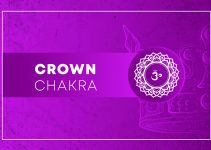


Thank you so much